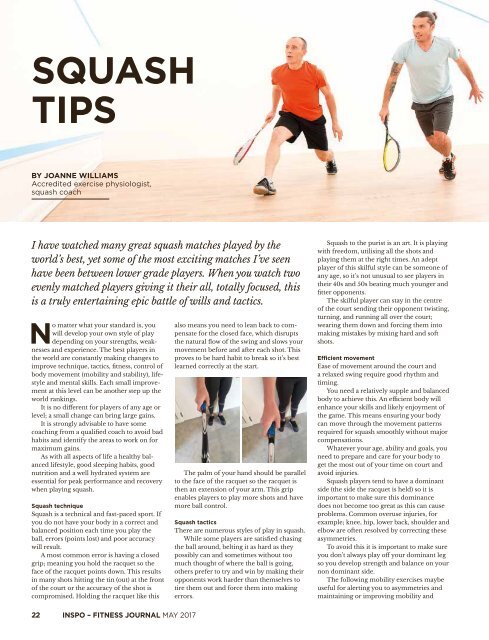INSPO Fitness Journal May 2017
Everything from nutrition, beauty, home and workplace wellbeing to health, performance – and so much more.
Everything from nutrition, beauty, home and workplace wellbeing to health, performance – and so much more.
You also want an ePaper? Increase the reach of your titles
YUMPU automatically turns print PDFs into web optimized ePapers that Google loves.
SQUASH<br />
TIPS<br />
BY JOANNE WILLIAMS<br />
Accredited exercise physiologist,<br />
squash coach<br />
I have watched many great squash matches played by the<br />
world’s best, yet some of the most exciting matches I’ve seen<br />
have been between lower grade players. When you watch two<br />
evenly matched players giving it their all, totally focused, this<br />
is a truly entertaining epic battle of wills and tactics.<br />
No matter what your standard is, you<br />
will develop your own style of play<br />
depending on your strengths, weaknesses<br />
and experience. The best players in<br />
the world are constantly making changes to<br />
improve technique, tactics, fitness, control of<br />
body movement (mobility and stability), lifestyle<br />
and mental skills. Each small improvement<br />
at this level can be another step up the<br />
world rankings.<br />
It is no different for players of any age or<br />
level; a small change can bring large gains.<br />
It is strongly advisable to have some<br />
coaching from a qualified coach to avoid bad<br />
habits and identify the areas to work on for<br />
maximum gains.<br />
As with all aspects of life a healthy balanced<br />
lifestyle, good sleeping habits, good<br />
nutrition and a well hydrated system are<br />
essential for peak performance and recovery<br />
when playing squash.<br />
Squash technique<br />
Squash is a technical and fast-paced sport. If<br />
you do not have your body in a correct and<br />
balanced position each time you play the<br />
ball, errors (points lost) and poor accuracy<br />
will result.<br />
A most common error is having a closed<br />
grip; meaning you hold the racquet so the<br />
face of the racquet points down. This results<br />
in many shots hitting the tin (out) at the front<br />
of the court or the accuracy of the shot is<br />
compromised. Holding the racquet like this<br />
also means you need to lean back to compensate<br />
for the closed face, which disrupts<br />
the natural flow of the swing and slows your<br />
movement before and after each shot. This<br />
proves to be hard habit to break so it’s best<br />
learned correctly at the start.<br />
The palm of your hand should be parallel<br />
to the face of the racquet so the racquet is<br />
then an extension of your arm. This grip<br />
enables players to play more shots and have<br />
more ball control.<br />
Squash tactics<br />
There are numerous styles of play in squash.<br />
While some players are satisfied chasing<br />
the ball around, belting it as hard as they<br />
possibly can and sometimes without too<br />
much thought of where the ball is going,<br />
others prefer to try and win by making their<br />
opponents work harder than themselves to<br />
tire them out and force them into making<br />
errors.<br />
Squash to the purist is an art. It is playing<br />
with freedom, utilising all the shots and<br />
playing them at the right times. An adept<br />
player of this skilful style can be someone of<br />
any age, so it’s not unusual to see players in<br />
their 40s and 50s beating much younger and<br />
fitter opponents.<br />
The skilful player can stay in the centre<br />
of the court sending their opponent twisting,<br />
turning, and running all over the court;<br />
wearing them down and forcing them into<br />
making mistakes by mixing hard and soft<br />
shots.<br />
Efficient movement<br />
Ease of movement around the court and<br />
a relaxed swing require good rhythm and<br />
timing.<br />
You need a relatively supple and balanced<br />
body to achieve this. An efficient body will<br />
enhance your skills and likely enjoyment of<br />
the game. This means ensuring your body<br />
can move through the movement patterns<br />
required for squash smoothly without major<br />
compensations.<br />
Whatever your age, ability and goals, you<br />
need to prepare and care for your body to<br />
get the most out of your time on court and<br />
avoid injuries.<br />
Squash players tend to have a dominant<br />
side (the side the racquet is held) so it is<br />
important to make sure this dominance<br />
does not become too great as this can cause<br />
problems. Common overuse injuries, for<br />
example; knee, hip, lower back, shoulder and<br />
elbow are often resolved by correcting these<br />
asymmetries.<br />
To avoid this it is important to make sure<br />
you don’t always play off your dominant leg<br />
so you develop strength and balance on your<br />
non dominant side.<br />
The following mobility exercises maybe<br />
useful for alerting you to asymmetries and<br />
maintaining or improving mobility and<br />
22 <strong>INSPO</strong> – FITNESS JOURNAL MAY <strong>2017</strong>


















